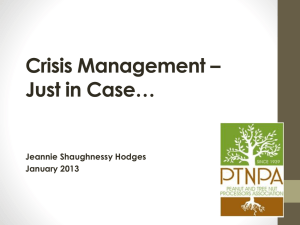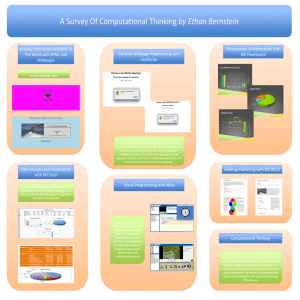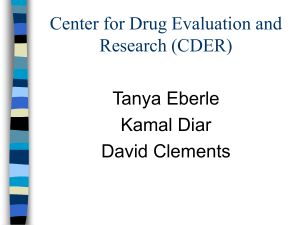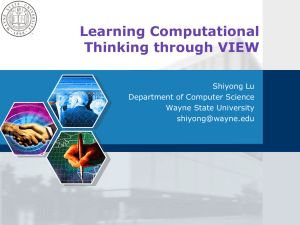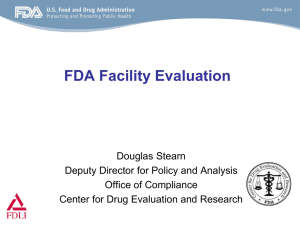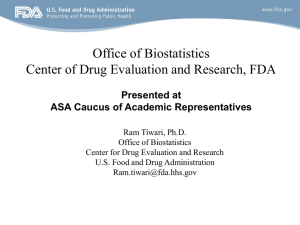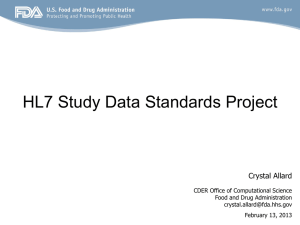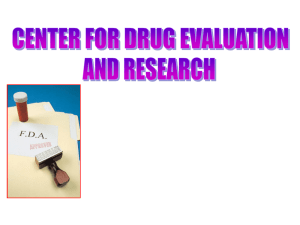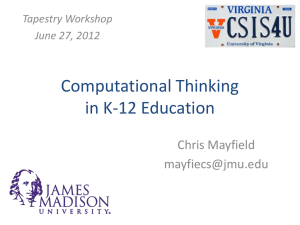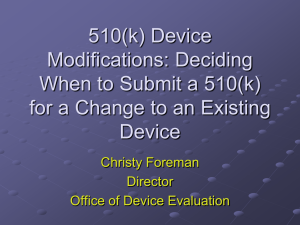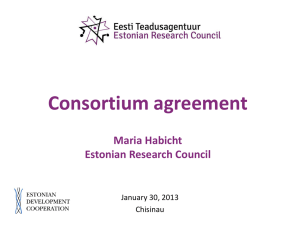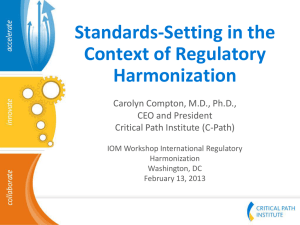Collaborating on “Opportunities Disguised as Problems
advertisement
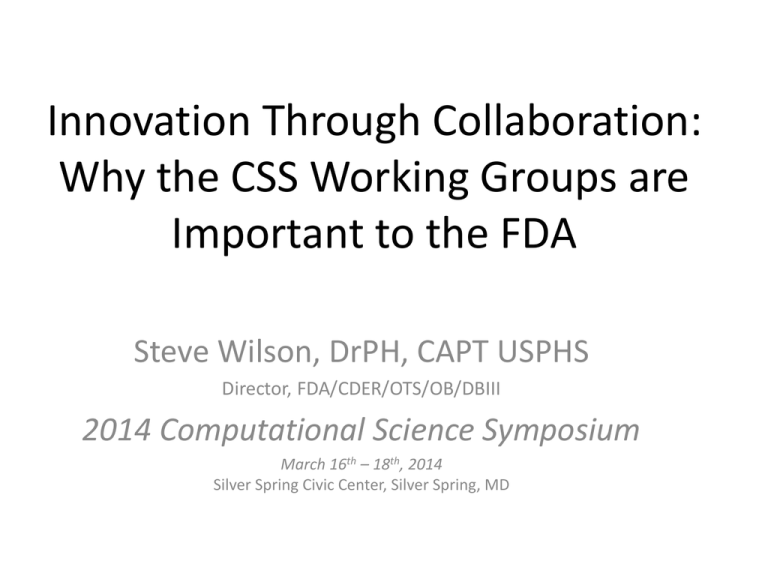
Innovation Through Collaboration: Why the CSS Working Groups are Important to the FDA Steve Wilson, DrPH, CAPT USPHS Director, FDA/CDER/OTS/OB/DBIII 2014 Computational Science Symposium March 16th – 18th, 2014 Silver Spring Civic Center, Silver Spring, MD Our Grand Experiment in Collaboration: “Opportunities Disguised as Problems” in this Fast-Paced, Complex Scientific/Regulatory/Technical Decision-Making World Steve Wilson, DrPH, CAPT USPHS Director, FDA/CDER/OTS/OB/DBIII 2014 Computational Science Symposium March 16th – 18th, 2014 Silver Spring Civic Center, Silver Spring, MD Disclaimer • This presentation reflects the views of the authors and should not be construed to represent FDA’s views or policies Computer-Assisted Review of Safety (CARS) Computer-Assisted Review of Safety (CARS) • Mission/Vision • The Landscape Outline – Motivation • • • • PDUFA/FDASIA 21st Century Review CDER says -- “Show Me the Data” Our “Computational Science”: Is Something Missing? – How Are We Going To “Get There” – CDER/OTS and “Pre-competitive” Collaboration • Consortia and Institutional Collaboration • Computational Science Symposium (CSS) • The Experiment – Some Challenges – Progress • Bottom Line Mission / Vision • FDA's mission is to protect and advance public health by helping to speed innovations that provide our nation with safe and effective medical products and that keep our food safe. • The Agency achieves this by applying the latest technology and science-based standards to the regulatory challenges presented by drugs, biologics (vaccines, blood products, cell and gene therapy products, and tissues), medical devices, food additives, and, since 2009, tobacco Innovation PDUFA / FDASIA • Efficiency/Predictability of processes • Promote innovation • Goals Letter: – B. Assessment of the Program … “be evaluated by an independent contractor with expertise in assessing the quality and efficiency of biopharmaceutical development and regulatory review programs.” – XII. IMPROVING THE EFFICIENCY OF HUMAN DRUG REVIEW THROUGH REQUIRED ELECTRONIC SUBMISSIONS AND STANDARDIZATION OF ELECTRONIC DRUG APPLICATION DATA 21st Century Review 21st Century Review CDER says -- “Show Me the Data” 12 Copyright CDER says – Show me the data! Assessing Potential Liver Injury [by Analyzing Increases in Serum Alanine Aminotransferase (ALT) and Total Serum Bilirubin (TBILI)] Drug experience Data Adverse Event Data Individual Patient Profile: Linkage of several data tables using the same timeline Concomitant Drugs Laboratory Data X-axis: Days into Study 13 Cooper, 2010 The Critical Path— Data Standards Our “Computational Science”: Is Something Missing? • • • • Tool development / standards – on-going Data quality / documentation / language Submission processes Application: Relevant Science and DecisionMaking • Training • Acceptance by Regulatory Agencies, Industry, Academia SO … How Are We Going to “Get There”? CDER/OTS and “Pre-competitive” Collaboration Examples of Public-Private Partnerships with CDER Participation Analgesic Clinical Trial Translations, Innovations, Opportunities, and Networks (ACTTION) Initiative Cardiac Safety Research Consortium (CSRC) Biomarker Consortium (BC) fNIH International Serious Adverse Events Consortium (iSAEC) Clinical Trials Transformation Initiative (CTTI) Coalition Against Major Diseases Consortium (CAMD) Polycystic Kidney Disease Consortium (PKD) Pediatric Anesthesia Safety Initiative (PASI) Critical Path Institute (CPath) Patient Reported Outcomes Consortium (PRO) Predictive Safety Testing Consortium (PSTC) Critical Path to TB Drug Regimens Consortium (CPTR) McCune, 2012 Computational Science Symposium (CSS) • 2014 CSS is the 5th in a Series of Annual Computational Science Meetings established to support the work of FDA’s Center for Drug Evaluation and Research (CDER), Office of Computational Science (OSC) • 3rd Year working with PhUSE (first two were with the DIA) • Intention: To work collaboratively with industry, vendors and regulators in a “non-competitive space” to find solutions and advance the computational sciences/technology associated with the development and regulation of new medical products (drugs, biologics, etc.) Meetings 2.0 – Computational Science Symposium • A different kind of conference: A Collaborative Workgroup Symposium • Organizing Committee: Currently defined 4 “working groups” to continue the work throughout the year • Supporting collaborative workgroups that will continue until all of the work is done. • Technical “Stakeholder Workgroups” – but we are asking you to move beyond “your stake” … act as knowledgeable professionals seeking solutions • Work Products, timelines, next steps • Job much bigger than these workgroups – this is a start The Experiment: Tom Sawyer & The Fence The Experiment • Progress • Some Challenges Progress: Current Workgroups • Optimizing the Use of Data Standards • Development of Standard Scripts for Analysis and Programming • Non-Clinical Road-map and Impacts on Implementation Emerging Technologies • Emerging Technologies Progress: Deliverables Progress: The Wiki Some Challenges • • • • • • • Volunteer / Co-Lead Right Projects Transparency/”Optics” Recognition/Appreciation FDA Involvement – Disclaimer & “Liaison” Wiki and “Agile Communication” Testing and “Socialization of Deliverables” stephen.wilson@fda.hhs.gov Adapted from Oliva,, 2007
